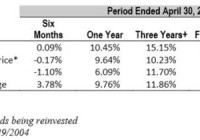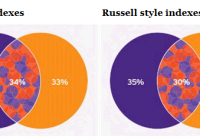When it comes to investing, simple is sometimes beautiful. If you don’t actually like investing, doing as little as possible is definitely beautiful. And that can make the often misunderstood balanced fund beautiful. Investing isn’t easy. In fact, for some people it’s a daunting, even painful, task that quickly overwhelms. And, in the end, that can lead people to do the worst possible thing-nothing. For such people, and for those just starting their investing journey, the best option may be the misunderstood balanced fund. A beautiful breed of creatures that even experienced investors can learn to love if only you take the time to get to know them. What is a balanced fund? At the core, a balanced fund is meant to be a complete portfolio in one investment. In other words, it is quite possible that you could buy a single balanced fund and never make another investment decision again. At that point, all you ever need worry about is saving money. That is beautiful. But there are really three different kinds of funds that can be found in this broad category. There are balanced funds, asset allocation funds, and flexible funds. The differences can be pretty minor, but they are worth knowing. A balanced fund generally has a target allocation for stocks and bonds. However, it can usually make minor adjustments around those bands. For example, a fund might say that it will have between 40% and 80% of assets in equities at all time, with the remainder in bonds. In function the goal might be to have a 60%/40% split between stocks and bonds. However, the bands give the management team the ability to become more or less aggressive based on prevailing market conditions. An asset allocation fund, meanwhile, tends to be far more rigid in its approach. These funds are usually based off of modern portfolio theory and so called efficient frontiers. Essentially management figures out an allocation between different asset classes based on achieving the highest possible return for a desired amount of risk. Of course that’s based on past performance, so it doesn’t always work as planned. The key difference here is that this approach usually goes well beyond the simple stock/bond portfolio, taking into account slivers of the market such as large-cap growth, large-cap value, small-cap growth, small-cap value, precious metals, emerging markets, developed foreign markets, bonds, foreign bonds, emerging market bonds, high-yield bonds, real estate, etc. You can slice and dice a lot in the financial world. But in the end, the fund will have a fairly rigid percentage guideline for each asset class they include and stick close to it. Flexible funds can be similar to both asset allocation and balanced funds except that the managers can really do whatever they want allocation wise. In other words, they can go 100% stock or 100% bond or 100% cash or any combination they want. There are a lot fewer funds that follow this approach nowadays since modern portfolio theory and efficient frontiers have come into prominence. That said, there are some funds that act like the other two that might better be placed here. For example, the Vanguard Managed Payout Fund (MUTF: VPGDX ) decided to completely remove real estate funds from its portfolio in late 2013. A true asset allocation fund wouldn’t have done that. What’s the best option? Honestly, at some level the differences are minor enough to be meaningless. Yes, it would be a good idea to know what your fund does. But for an investor who hates investing, it’s far more important that you save money and invest than that you pick the perfect balanced fund variant. In the end, your efforts at saving money will be more important to your end results than the fund you pick. So don’t get bogged down in selecting a fund. That said, the simplest approach is probably a fund like the Vanguard Balanced Index Fund (MUTF: VBINX ). It has a 60%/40% split between the entire U.S. stock market (via an index fund that tracks the entire U.S. stock market) and the entire U.S. bond market (via an index fund that tracks the entire U.S. bond market). You can’t get more basic than that. And that split is rigidly maintained, so this is a true balanced fund and would work well for just about anyone. But if you like a little more zest, you might prefer something like Dodge & Cox Balanced Fund (MUTF: DODBX ). Dodge & Cox is a relatively small, though well respected, value focused shop. The fund is a balanced fund, too, but it has an allocation band for stocks of between 25% and 75%. The rest goes into bonds and cash. This fund would provide you the comfort of knowing that it can shift with the market and, for those of you who like to buy on the cheap, it uses a value approach to investing. This, too, would be a great option for most investors-except, perhaps, for those who prefer growth stocks. On the asset allocation front a simple example is Fidelity Four-In-One Index Fund (MUTF: FFNOX ). Although many funds get into far more detail, this one gives a reasonable view of the difference between a balanced fund, like Vanguard Balanced Index which owns all U.S. stocks and all U.S. bonds, and asset allocation, which engages a broader list of asset classes. In Fidelity Four-in-One’s case, those asset classes are large-cap U.S. stocks (48% of assets), small-cap U.S. stocks (12%), foreign stocks (25%), and U.S. bonds (15%). The fund tries to adhere to these allocations fairly closely and each is represented with an index fund. Flexible funds are often harder to find. However, they can hide in plain sight, too. My earlier example of Vanguard Managed Distribution Fund shows this. The fund has a model allocation to follow, but it doesn’t have to do so rigidly and can change. The shift out of real estate investment trusts is a good example. And several of the investment approaches it uses can’t be easily categorized into an asset class. For example, it invests in a market neutral strategy and a “minimum volatility” fund. What those two funds actually do is beyond the discussion here, but what’s important is that they don’t fit in a box and allow the fund to shift around a lot more than either a true balanced or asset allocation fund. That’s neither good nor bad, but it is something to understand. OK, now what? For people who really hate investing, but know they have to do it, my recommendation is usually Vanguard Index Balanced Fund. It’s fine, not great, not bad-just fine. And that’s enough for most people. For those who want to get into investing a little more, I’d say look at the other funds I mentioned and expand from there. But try to stick with a major fund company and try to keep expenses low. Your deciding factor should be finding a fund that feels like it fits with your personality. The goal is to pick something that you’ll be able to stick to for a long, long time. For new investors, this is a great way to start putting money to work while you start to learn about investing. For example, you might put the bulk of your money in a balanced, asset allocation, or flexible fund and keep say 20% on the side for you to start buying individual stocks. That way the bulk of your money is in what you might consider a foundation fund while you experiment with the rest of the house. As you get more experienced you can start shifting that balance more toward you managing your own money. Or not. For a more experienced investor, you might place a chunk of change into a balanced fund as the core of your portfolio and then use the rest to focus in on asset classes you know well. For example, buying Dodge & Cox Balanced Fund as a core holding (say 60% of your portfolio), and then buying large cap growth stocks. This would allow you to focus on an area in which you are most comfortable without undue overlap with your core. I normally call this a core and explore type approach. You could also substitute in real estate investment trusts, closed-end funds, and limited partners for growth, if you wanted. The general idea being the same in that you rely on the fund for broader diversification while you do the things that you do best (or the things you enjoy). The biggest impact you’ll have There are a wide variety of ways to use balanced, asset allocation, and flexible funds. However, what they really do is provide simplification. And that’s more important than you may think. Investing can be very, very complicated if you let it. This can distract from what will be your most important contribution to your future financial success-the amount of money you save. And, in the end, saving is really the hard part of this because we humans are notoriously bad at delaying gratification. So, if you are new to investing or hate the idea of investing, find a decent one-and-you’re-done fund and focus on saving money. As you get more comfortable you can change how you do things. But start by, well, starting simple. And if you are more experienced, don’t overlook the value of a sound, and diversified, foundation around which you can build a core and explore portfolio. In the end, sometimes, all you really need is one single solitary fund. Disclosure: I/we have no positions in any stocks mentioned, and no plans to initiate any positions within the next 72 hours. (More…) I wrote this article myself, and it expresses my own opinions. I am not receiving compensation for it (other than from Seeking Alpha). I have no business relationship with any company whose stock is mentioned in this article.

